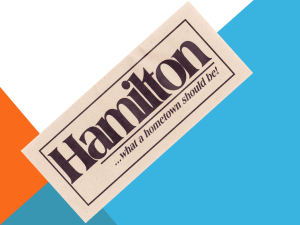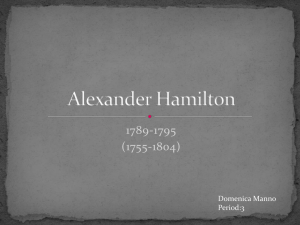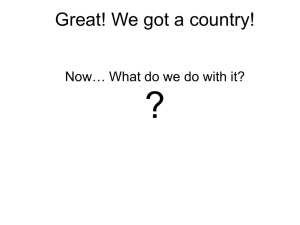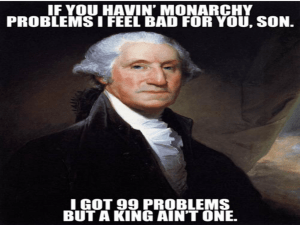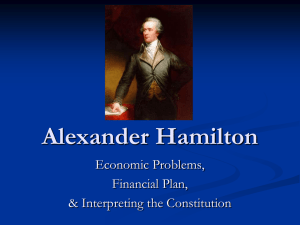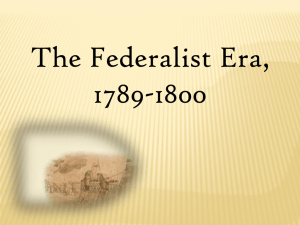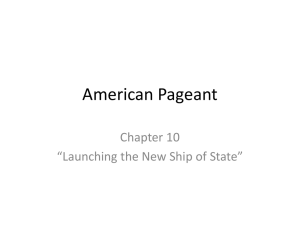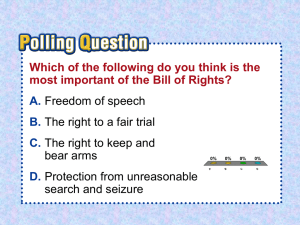Block Outcomes - Hamilton Trust
advertisement
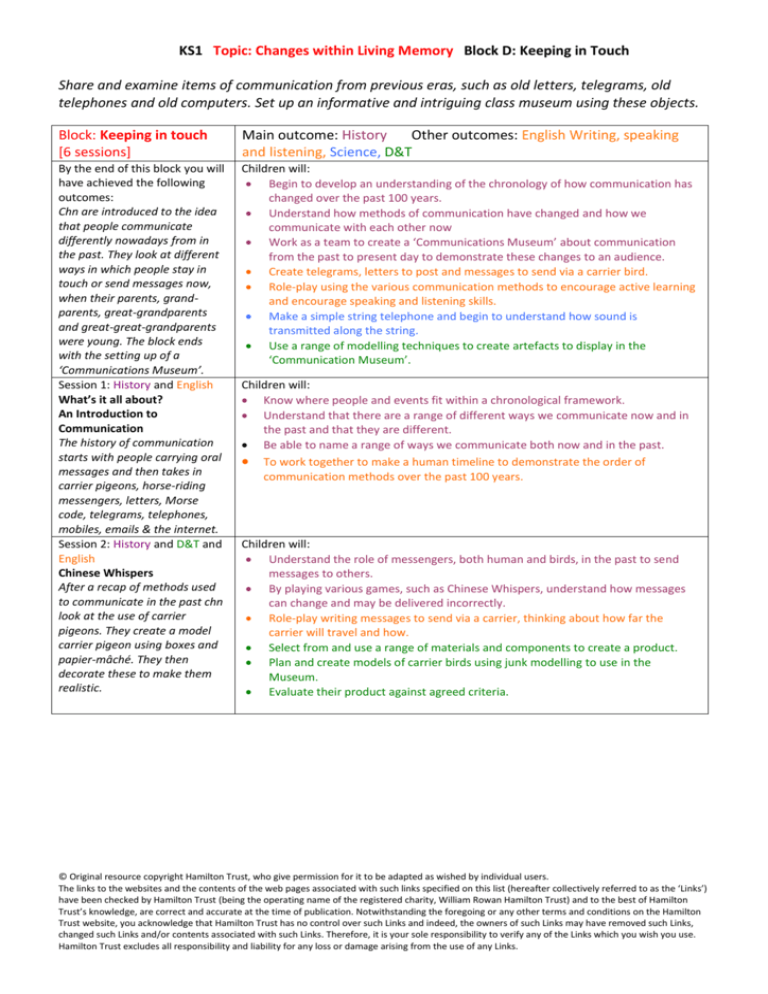
KS1 Topic: Changes within Living Memory Block D: Keeping in Touch Share and examine items of communication from previous eras, such as old letters, telegrams, old telephones and old computers. Set up an informative and intriguing class museum using these objects. Block: Keeping in touch [6 sessions] Main outcome: History Other outcomes: English Writing, speaking and listening, Science, D&T By the end of this block you will have achieved the following outcomes: Chn are introduced to the idea that people communicate differently nowadays from in the past. They look at different ways in which people stay in touch or send messages now, when their parents, grandparents, great-grandparents and great-great-grandparents were young. The block ends with the setting up of a ‘Communications Museum’. Session 1: History and English What’s it all about? An Introduction to Communication The history of communication starts with people carrying oral messages and then takes in carrier pigeons, horse-riding messengers, letters, Morse code, telegrams, telephones, mobiles, emails & the internet. Session 2: History and D&T and English Chinese Whispers After a recap of methods used to communicate in the past chn look at the use of carrier pigeons. They create a model carrier pigeon using boxes and papier-mâché. They then decorate these to make them realistic. Children will: Begin to develop an understanding of the chronology of how communication has changed over the past 100 years. Understand how methods of communication have changed and how we communicate with each other now Work as a team to create a ‘Communications Museum’ about communication from the past to present day to demonstrate these changes to an audience. Create telegrams, letters to post and messages to send via a carrier bird. Role-play using the various communication methods to encourage active learning and encourage speaking and listening skills. Make a simple string telephone and begin to understand how sound is transmitted along the string. Use a range of modelling techniques to create artefacts to display in the ‘Communication Museum’. Children will: Know where people and events fit within a chronological framework. Understand that there are a range of different ways we communicate now and in the past and that they are different. Be able to name a range of ways we communicate both now and in the past. To work together to make a human timeline to demonstrate the order of communication methods over the past 100 years. Children will: Understand the role of messengers, both human and birds, in the past to send messages to others. By playing various games, such as Chinese Whispers, understand how messages can change and may be delivered incorrectly. Role-play writing messages to send via a carrier, thinking about how far the carrier will travel and how. Select from and use a range of materials and components to create a product. Plan and create models of carrier birds using junk modelling to use in the Museum. Evaluate their product against agreed criteria. © Original resource copyright Hamilton Trust, who give permission for it to be adapted as wished by individual users. The links to the websites and the contents of the web pages associated with such links specified on this list (hereafter collectively referred to as the ‘Links’) have been checked by Hamilton Trust (being the operating name of the registered charity, William Rowan Hamilton Trust) and to the best of Hamilton Trust’s knowledge, are correct and accurate at the time of publication. Notwithstanding the foregoing or any other terms and conditions on the Hamilton Trust website, you acknowledge that Hamilton Trust has no control over such Links and indeed, the owners of such Links may have removed such Links, changed such Links and/or contents associated with such Links. Therefore, it is your sole responsibility to verify any of the Links which you wish you use. Hamilton Trust excludes all responsibility and liability for any loss or damage arising from the use of any Links. KS1 Topic: Changes within Living Memory Block D: Keeping in Touch Session 3: History and English and D&T A Telegram from the Queen! Children look at how telegrams were developed, including exploring the use of Morse Code. They write their names in code and then create telegrams using Tea-paper to create an aged effect. Session 4: History and English Thank you Mr. Postman Children understand how the Royal Mail came to exist and how letters were sent in the past. They identify pillar-boxes and then write a letter to an older person for whom this was an important form of communication. Session 5: History and Science It’s Good to Talk! The development of the telephone from the late 19th century to mobile phones in the present day is charted. Chn study pictures of phones of each era, from their great-greatgreat-grandparents to now. They create a string telephone and then subject it to a series of ‘fair tests’. Session 6: History and English A Day at the Museum! To round off the Block, chn set up a class museum of the history of communication. They label artefacts and produce records for all this that have been lent or given. They discuss and then help to produce a catalogue before opening for visitors! Children will: Understand the history of telegrams and why they were used. Ask and answer questions using historical vocabulary. Recognise that there are a number of sources for historical information. Use ‘tea bag’ dying to create an aged effect. Create a realistic telegram using the tea-paper and appropriate language. Write a simple telegram to a chosen person. Children will: Understand why we began writing letters as a form of communication and what forms of communication we may use now as an alternative, e.g. email, text. Look at changes within living memory and use these to reveal aspects of change in National life. To write a letter to someone who remembers how we used letters to communicate before we had emails and texts. Children will: Begin to understand how the telephone was developed and over what timespan. Learn about how the telephone has changed since being invented (from the first telephone to today’s smart phones). Recognise the telephone as a key invention in relation to human communication. Place images of various telephones from the past 100 years in time order in the Museum. Make string telephones to begin to understand how the sound travels along the string to the other person. Perform a fair test to ascertain under what conditions the string telephone functions best. Children will: Demonstrate their understanding of communication methods over the past 100 years to an audience. Create a Museum and display their artefacts for an audience. Identify ways in which the past is represented. Write descriptive labels and write record sheets for objects. Plan and design effective labels for museum artefacts. © Original resource copyright Hamilton Trust, who give permission for it to be adapted as wished by individual users. The links to the websites and the contents of the web pages associated with such links specified on this list (hereafter collectively referred to as the ‘Links’) have been checked by Hamilton Trust (being the operating name of the registered charity, William Rowan Hamilton Trust) and to the best of Hamilton Trust’s knowledge, are correct and accurate at the time of publication. Notwithstanding the foregoing or any other terms and conditions on the Hamilton Trust website, you acknowledge that Hamilton Trust has no control over such Links and indeed, the owners of such Links may have removed such Links, changed such Links and/or contents associated with such Links. Therefore, it is your sole responsibility to verify any of the Links which you wish you use. Hamilton Trust excludes all responsibility and liability for any loss or damage arising from the use of any Links. KS1 Topic: Changes within Living Memory Block D: Keeping in Touch Resources Session 1 Provided: A5 Cards of Past and Present methods of Communication; PowerPoint presentation of methods of communication; large printed photos of all methods of communication discussed with dates. You will need: Blank Timeline and teacher version of timeline; scissors, pens, pencils and glue. Session 2 Provided: Instructions for making model messenger pigeons. You will need: Small pieces of lined paper for writing messages; range of small boxes; card; papier-mâché; tissue paper; feathers; scissors; masking tape. Session 3 Provided: History of the telegram; Morse Code sheet; communications from the Queen; telegram examples; telegrams to write on, enough copies for every child. You will need: Tea bags and bowls of warm water; Drying rack or line. Session 4 Provided: Explanation of Rowland Hill’s postal system; post Box image; story of the post; examples of stamps; examples of letters; letter template. You will need: Pencils/writing pens; a letter addressed to the class in an envelope with a stamp. It needs to be from a fantasy character (Buzz Lightyear or Batman or whatever character your children will recognise and like). Session 5 Provided: Pictures from the resources to stick along the time line; history of telephone in pictures. You will need: Paper cups; string (10m lengths); paper clips; scissors or sharp pencils; an old-fashioned dial telephone. Session 6 Provided: Resources from previous sessions; writing a label template; writing an object recording sheet template. You will need: Previously created resources; a scrapbook (for the catalogue); pens; card; crayons. © Original resource copyright Hamilton Trust, who give permission for it to be adapted as wished by individual users. The links to the websites and the contents of the web pages associated with such links specified on this list (hereafter collectively referred to as the ‘Links’) have been checked by Hamilton Trust (being the operating name of the registered charity, William Rowan Hamilton Trust) and to the best of Hamilton Trust’s knowledge, are correct and accurate at the time of publication. Notwithstanding the foregoing or any other terms and conditions on the Hamilton Trust website, you acknowledge that Hamilton Trust has no control over such Links and indeed, the owners of such Links may have removed such Links, changed such Links and/or contents associated with such Links. Therefore, it is your sole responsibility to verify any of the Links which you wish you use. Hamilton Trust excludes all responsibility and liability for any loss or damage arising from the use of any Links.
